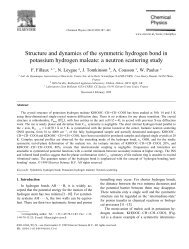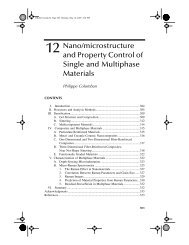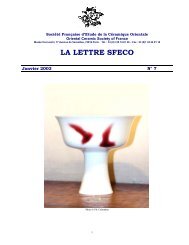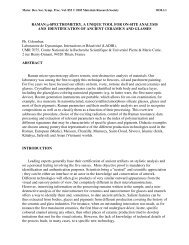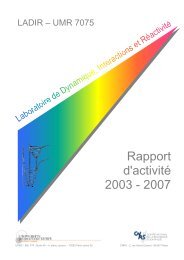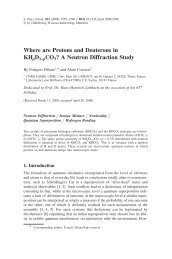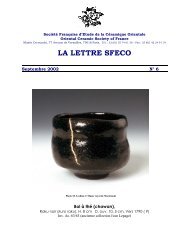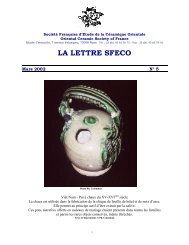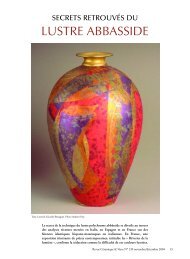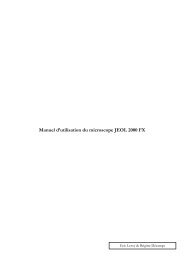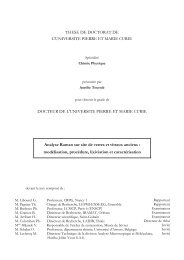Raman Spectroscopy of nanomaterials - institut de chimie et des ...
Raman Spectroscopy of nanomaterials - institut de chimie et des ...
Raman Spectroscopy of nanomaterials - institut de chimie et des ...
Create successful ePaper yourself
Turn your PDF publications into a flip-book with our unique Google optimized e-Paper software.
X i¼ni¼1ARTICLE IN PRESS+ MODELG. Goua<strong>de</strong>c, Ph. Colomban / Progress in Crystal Growth and Characterization <strong>of</strong> Materialsxx (2007) 1e56~k i ¼ ~k scattered~k inci<strong>de</strong>nt z~0 ð5ÞTherefore, only vibrations from the centre <strong>of</strong> BZ (BZ c ), i.e. long wavelength phonons can beactive in any one phonon process (first or<strong>de</strong>r spectrum). 4 However, not all BZ c phonons are activein RS. According to Eq. (3), va ij /vQ terms must be different from zero and this condition isgoverned by the symm<strong>et</strong>ry <strong>of</strong> the crystals. <strong>Raman</strong> activity can therefore be predicted throughGroup Theory [52].An interesting feature <strong>of</strong> Eq. (3) is to reveal the dual sensitivity <strong>of</strong> RS to the electrical (a ij )and mechanical (n vib ) properties <strong>of</strong> the investigated materials. Two kinds <strong>of</strong> param<strong>et</strong>ers willtherefore influence the spectra:(i) Param<strong>et</strong>ers acting on the ‘‘mechanics’’ like atomic mass, bond strength or the systemgeom<strong>et</strong>ry (interatomic distances, atomic substitutions) will s<strong>et</strong> the peaks’ positions(the eigenfrequencies <strong>of</strong> matter vibrations).(ii) Param<strong>et</strong>ers acting on the ‘‘charge transfer’’ (iono-covalency, band structure, electronicinsertion) will s<strong>et</strong> intensity, on the basis <strong>of</strong> the vibration-induced charge variations occurringat the very bond scale. 5As polarisability changes for different kinds <strong>of</strong> bonds, <strong>Raman</strong> intensity may not be used toquantitatively <strong>de</strong>termine the amounts <strong>of</strong> different phases. This limitation can som<strong>et</strong>imes be anadvantage since some secondary phase like an enamel pigment [59e61] or carbon in SiC fibres[38] can be <strong>de</strong>tected in a very small quantity (even traces) and its crystalline structure i<strong>de</strong>ntified[62]. Elements with high atomic numbers that are situated on the right si<strong>de</strong> <strong>of</strong> the periodic table(covalent materials in general) are good <strong>Raman</strong> scatterers whereas ionic structures are difficultto analyse with RS. As for the m<strong>et</strong>als, their surface plasmons limit the pen<strong>et</strong>ration <strong>of</strong> the light.Thus, their <strong>Raman</strong> signal is extremely weak. 6 There are, however, compounds like the superconductingYBaCuO oxi<strong>de</strong>s in which m<strong>et</strong>al atoms produce a strong <strong>Raman</strong> signal, owing totheir covalent bonding along certain directions <strong>of</strong> the structure [64,65]. Some transition m<strong>et</strong>alions from the 3d (chromium) or 4f (lanthani<strong>de</strong>s) groups produce strong fluorescence signalswhich <strong>of</strong>ten mask the <strong>Raman</strong> spectra but can be used for short range structure [66] and/or residualstress [67] assessment.54 It is actually the case in large and flawless crystals. For such materials, inelastic neutron scattering is the only way toexplore the BZ [50,51].5 The vibration <strong>of</strong> charged species is somewhat analogous to a high frequency conductivity. There is for instance a directlink b<strong>et</strong>ween the infrared absorption coefficients aðnÞ and the conductivity sðnÞ ([53], [50, pp. 375, 391]):aðnÞ¼ 4pnc sðnÞðN1ÞIn Eq. (N1), n is the refraction in<strong>de</strong>x and c is the light speed. There is also a formal equivalence b<strong>et</strong>ween the <strong>Raman</strong>intensity and sðnÞ [50, p. 375] but it has rarely been characterized on experimental <strong>Raman</strong> spectra [55]:I <strong>Raman</strong> ðnÞa nB ðnÞþ1sðnÞ; n B ¼ Bose occupation factorðN2ÞnThe presence <strong>of</strong> mobile charge carriers in ionic conductors can be revealed by a temperature <strong>de</strong>pen<strong>de</strong>nce <strong>of</strong> the intensity<strong>of</strong> the <strong>Raman</strong> bands [55,56]. Thorough discussions on ionic motions can be found in papers by Funke <strong>et</strong> al. [57,58].6 Hexagonal close-packed m<strong>et</strong>als like Be are an exception [63].Please cite this article in press as: G. Goua<strong>de</strong>c, Ph. Colomban, Prog. Cryst. Growth Charact. Mater. (2007),doi:10.1016/j.pcrysgrow.2007.01.001



